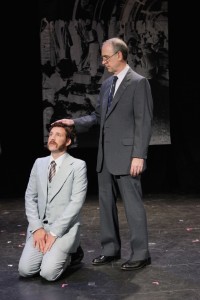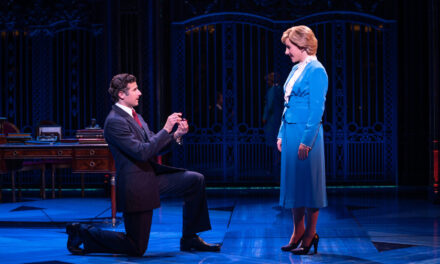by: Paulanne Simmons
On March 3, 1943, the air-raid Civil Defense Siren sounded in London at 8:17 pm, and people began descending the stairs of the Bethel Green station on the Central line of the Underground in London’s East End. A woman and child fell at the base of the stairs and in the ensuing panic, 173 people died and 60 others were hurt, making this the largest civilian disaster in the UK during World War II.
Because censors withheld news of the disaster for 36 hours, there were many questions about the nature and extent of the tragedy. But it turned out there was no sinister plot, just a staircase with no handrails, no central dividing rail and only one small blue light to show people where to go. Nevertheless, this incident became the inspiration for Jessica Francis Kane’s 2010 novel, The Report. And now Martin Casella has written a play by the same name that dramatizes Kane’s fictionalized account. It is one of the many offerings in this summer’s Fringe Festival.
Alan Muraoka directs an ensemble cast headed by Broadway veteran Michael Countryman as Sir Laurence Dunne, the local magistrate who was asked to write a report and, it was hoped, find out exactly what happened. The play begins when Paul Barber (Stuart Williams), a documentary filmmaker who has personal reasons for his interest in the catastrophe, solicits Dunne’s help. This initiates a series of flashbacks that alternate with scenes in which Dunne and Barber comment on what may or may not have occurred.
Casella offers several possibilities. The lighting was poor. The stairway was badly constructed and unsafe. The government was testing anti-aircraft rockets. And finally, the one that seems to carry the day, one of the locals pushed an immigrant Jewish lady down the stairs, after which the panicking crowd trampled her to death.
The play is filled with so many red herrings and unanswered question it’s hard to figure out exactly who or what was at fault, and whether it would even matter if one could make a determination. There are also side trips into the role of a woman who adopts a circumcised baby whose mother died during the stampede, and her tight-lipped daughter, the faith of the local vicar and the self-recriminations of the local warden. All this makes The Report not only confusing but also way too long.
The acting ranges from impeccable (Countryman) to bungling, with at least one of the actors forgetting lines so frequently it becomes embarrassing. As with most Fringe shows, the props and scenery are very minimal, which in this case makes it even harder to figure out what’s going on.
The Report does treat a fascinating subject and its themes of prejudice, panic and guilt are certainly worthy of exploration. What’s more, at times ambiguity can be a virtue. But when ambiguity becomes confusion, the drama suffers.
The Report, at Venue 13: Lynn Redgrave Theater@Culture Project, 45 Bleecker St. through Aug. 28. www.TheReportThePlay.com or www.FringeNYC.org.
*Photos: Lia Chang
























